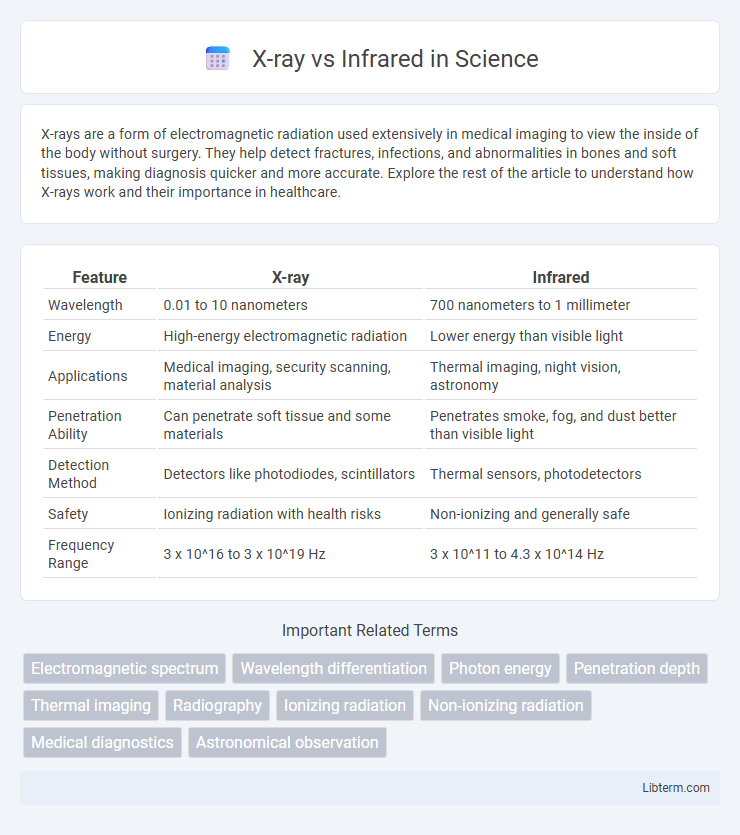X-rays are a form of electromagnetic radiation used extensively in medical imaging to view the inside of the body without surgery. They help detect fractures, infections, and abnormalities in bones and soft tissues, making diagnosis quicker and more accurate. Explore the rest of the article to understand how X-rays work and their importance in healthcare.
Table of Comparison
| Feature | X-ray | Infrared |
|---|---|---|
| Wavelength | 0.01 to 10 nanometers | 700 nanometers to 1 millimeter |
| Energy | High-energy electromagnetic radiation | Lower energy than visible light |
| Applications | Medical imaging, security scanning, material analysis | Thermal imaging, night vision, astronomy |
| Penetration Ability | Can penetrate soft tissue and some materials | Penetrates smoke, fog, and dust better than visible light |
| Detection Method | Detectors like photodiodes, scintillators | Thermal sensors, photodetectors |
| Safety | Ionizing radiation with health risks | Non-ionizing and generally safe |
| Frequency Range | 3 x 10^16 to 3 x 10^19 Hz | 3 x 10^11 to 4.3 x 10^14 Hz |
Introduction to X-ray and Infrared
X-rays are a form of electromagnetic radiation with wavelengths ranging from 0.01 to 10 nanometers, primarily used in medical imaging and material analysis due to their ability to penetrate various substances. Infrared radiation spans wavelengths from about 700 nanometers to 1 millimeter and is commonly employed in thermal imaging, remote sensing, and communication technologies. Both X-rays and infrared belong to the electromagnetic spectrum but differ significantly in wavelength, energy, and practical applications.
Fundamental Principles of X-rays
X-rays are a form of electromagnetic radiation with wavelengths ranging from 0.01 to 10 nanometers, generated when high-energy electrons decelerate upon striking a metal target, producing ionizing radiation capable of penetrating various materials. Infrared radiation, in contrast, has longer wavelengths from 700 nanometers to 1 millimeter and primarily involves thermal emission from objects without ionizing effects. The fundamental principle of X-rays centers on their ability to traverse soft tissues while being absorbed by denser materials such as bones, enabling medical imaging and material analysis.
Core Concepts of Infrared Technology
Infrared technology operates on the principle of detecting electromagnetic radiation with wavelengths longer than visible light, typically ranging from 700 nm to 1 mm, which allows it to capture thermal radiation emitted by objects. Unlike X-rays that penetrate materials to reveal internal structures, infrared is primarily used for surface temperature measurement, night vision, and thermal imaging based on the heat emitted by objects. Core concepts include wavelength-specific detectors, thermal emission properties, and the ability to visualize temperature differences without harmful radiation exposure.
Applications of X-ray Imaging
X-ray imaging is extensively utilized in medical diagnostics to visualize bones, detect fractures, and identify tumors due to its ability to penetrate soft tissues while providing high-resolution images of dense structures. Industrial applications leverage X-ray imaging for non-destructive testing, revealing cracks and defects in materials and electronic components. In security, X-ray scanners are essential for inspecting luggage and cargo, enabling efficient detection of prohibited items and ensuring safety at airports and border checkpoints.
Uses of Infrared in Modern Systems
Infrared technology plays a crucial role in modern systems such as remote controls, thermal imaging, and night vision devices, enabling precise temperature measurement and secure wireless communication. Its ability to detect heat radiation allows for applications in medical diagnostics, environmental monitoring, and industrial quality control. Unlike X-rays, infrared radiation is non-ionizing, making it safer for continuous monitoring and consumer electronics.
Comparing X-ray and Infrared Wavelengths
X-ray wavelengths range from 0.01 to 10 nanometers, significantly shorter than infrared wavelengths, which span from 700 nanometers to 1 millimeter. This vast difference results in X-rays having much higher energy and frequency, enabling them to penetrate dense materials like bone and metal, unlike infrared radiation, which primarily interacts with surface temperatures and is used in thermal imaging. The distinct wavelength ranges influence their practical applications, with X-rays suited for medical imaging and material analysis, while infrared supports night vision and remote sensing technologies.
Advantages and Limitations of X-rays
X-rays offer superior penetration power and high-resolution imaging critical for medical diagnostics and security screening, enabling detailed visualization of bones and dense tissues. Their limitations include exposure to ionizing radiation, which poses health risks, and reduced effectiveness for imaging soft tissues compared to modalities like infrared. Despite these drawbacks, X-rays remain essential for detecting fractures, tumors, and foreign objects with precision not achievable by infrared imaging.
Benefits and Drawbacks of Infrared
Infrared technology offers non-invasive temperature measurement and effective night vision capabilities, making it valuable in medical, industrial, and security applications. However, its drawbacks include limited penetration abilities compared to X-rays, reduced accuracy in detecting internal structures, and sensitivity to environmental factors such as fog or smoke. Infrared's dependence on surface temperature limits its use in detailed diagnostic imaging where X-rays provide clearer internal views.
Safety Considerations: X-ray vs Infrared
X-rays, possessing high-energy ionizing radiation, pose significant safety risks such as tissue damage and increased cancer risk, necessitating strict exposure limits and protective measures. Infrared radiation, classified as non-ionizing, is generally safer but can cause thermal burns or eye damage with excessive exposure. Proper shielding, controlled exposure duration, and adherence to safety guidelines are critical in minimizing health hazards for both X-ray and infrared technologies.
Choosing Between X-ray and Infrared Technologies
Choosing between X-ray and infrared technologies depends on the application's requirements for penetration depth and material detection. X-rays provide high-resolution imaging of dense materials, making them ideal for medical diagnostics and security screening, while infrared technology excels in detecting surface temperature variations and identifying heat signatures. Selecting the appropriate technology involves balancing factors like safety, cost, and the specific characteristics of the object or environment being analyzed.
X-ray Infographic

 libterm.com
libterm.com